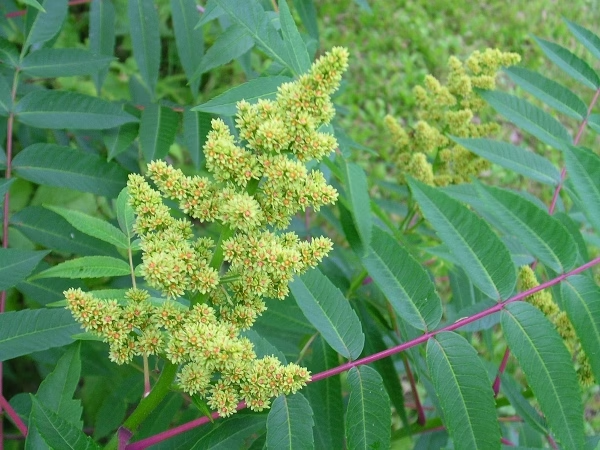
Sumac
Botanical Name
:
Rhus spp.
Plant Type
:
Deciduous shrub
Seasons
:
Plant in early spring or early fall; blooms from late spring to early summer
Sun Level
:
Full sun to partial shade; thrives in at least 6 hours sunlight daily
Ideal Soil Temperature for Planting
:
60–70°F (15–21°C)
Soil Type
:
Well-drained soil, tolerates a wide range of soil types including clay
Hardiness Zones
:
3–9 (USDA)
Germination
:
90–120 days
P.H. Level
:
5.5–7.0 (acidic to neutral)
Water/Irrigation
:
Keep soil consistently moist but not waterlogged. Mulch to retain moisture
Fertilization
:
Use a balanced fertilizer (e.g., 10-10-10) in early spring
Habit
:
Multi-stemmed, spreading shrub or small tree with arching branches
Propagation
:
By seed, softwood cuttings in early summer, or hardwood cuttings in late fall or early winter
Final Plant Height
:
5–20 ft, depending on the species
Spread
:
6–15 ft
Flowers
:
Small, greenish-white to creamy white flowers in dense panicles or spikes
Attracts
:
Bees, butterflies, and other pollinators
Uses
:
Ornamental, erosion control, wildlife habitat, hedges, and borders
Companions
:
Betula papyrifera (paper birch), Amsonia tabernaemontana (blue star), and Calamagrostis brachytricha (reed grass)
Pruning
:
Prune in late winter or early spring to remove dead or damaged wood and to maintain shape
Toxicity
:
Non-toxic to humans and pets, but some species (like poison sumac) can be highly toxic
Pests
:
Leaf miners, scale insects, borers, and aphids
Diseases
:
Anthracnose, powdery mildew, leaf spot, and canker
Additional Info
:
It’s native to North America and other temperate regions. Known for their colorful fall foliage and dense clusters of red or orange fruit (sumac bobs)
Botanical Name
:
Rhus spp.
Plant Type
:
Deciduous shrub
Seasons
:
Plant in early spring or early fall; blooms from late spring to early summer
Sun Level
:
Full sun to partial shade; thrives in at least 6 hours sunlight daily
Ideal Soil Temperature for Planting
:
60–70°F (15–21°C)
Soil Type
:
Well-drained soil, tolerates a wide range of soil types including clay
Hardiness Zones
:
3–9 (USDA)
Germination
:
90–120 days
P.H. Level
:
5.5–7.0 (acidic to neutral)
Water/Irrigation
:
Keep soil consistently moist but not waterlogged. Mulch to retain moisture
Fertilization
:
Use a balanced fertilizer (e.g., 10-10-10) in early spring
Habit
:
Multi-stemmed, spreading shrub or small tree with arching branches
Propagation
:
By seed, softwood cuttings in early summer, or hardwood cuttings in late fall or early winter
Final Plant Height
:
5–20 ft, depending on the species
Spread
:
6–15 ft
Flowers
:
Small, greenish-white to creamy white flowers in dense panicles or spikes
Attracts
:
Bees, butterflies, and other pollinators
Uses
:
Ornamental, erosion control, wildlife habitat, hedges, and borders
Companions
:
Betula papyrifera (paper birch), Amsonia tabernaemontana (blue star), and Calamagrostis brachytricha (reed grass)
Pruning
:
Prune in late winter or early spring to remove dead or damaged wood and to maintain shape
Toxicity
:
Non-toxic to humans and pets, but some species (like poison sumac) can be highly toxic
Pests
:
Leaf miners, scale insects, borers, and aphids
Diseases
:
Anthracnose, powdery mildew, leaf spot, and canker
Additional Info
:
It’s native to North America and other temperate regions. Known for their colorful fall foliage and dense clusters of red or orange fruit (sumac bobs)
Written by Nondiah Khalayi – https://www.linkedin.com/in/nondiah-khalayi/

